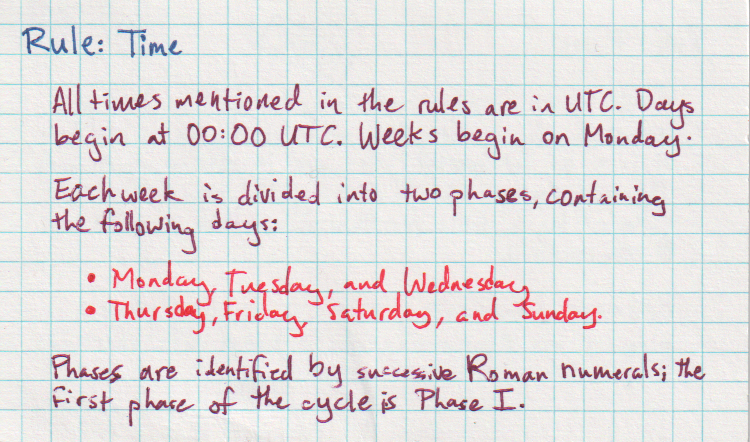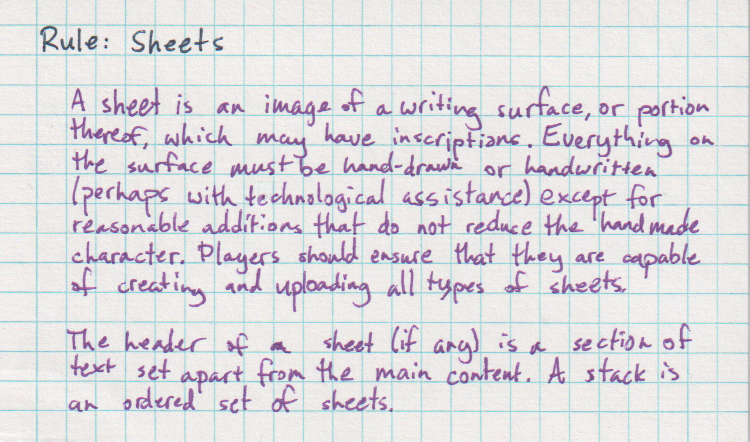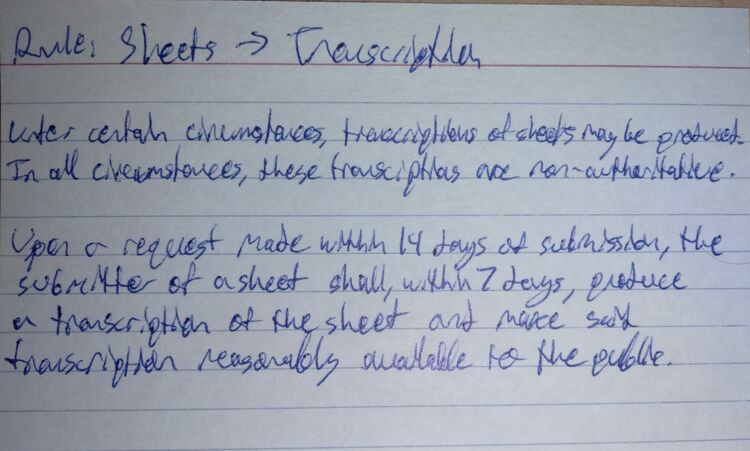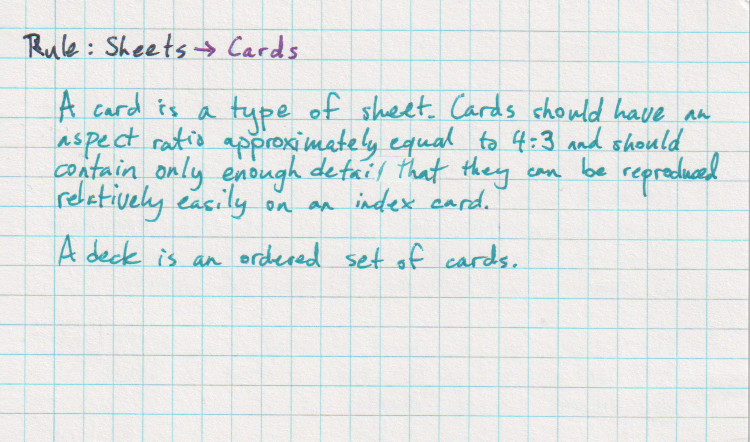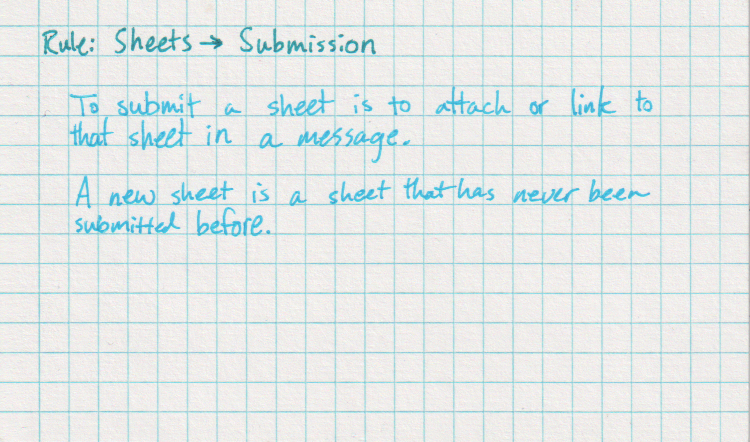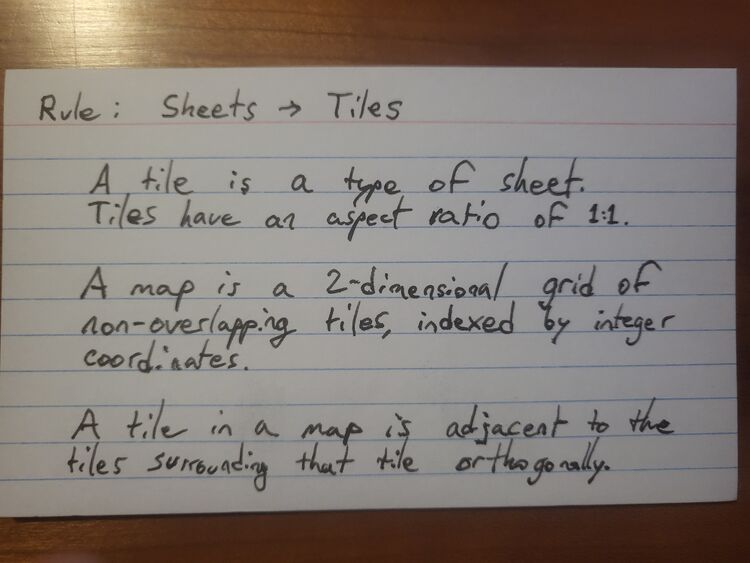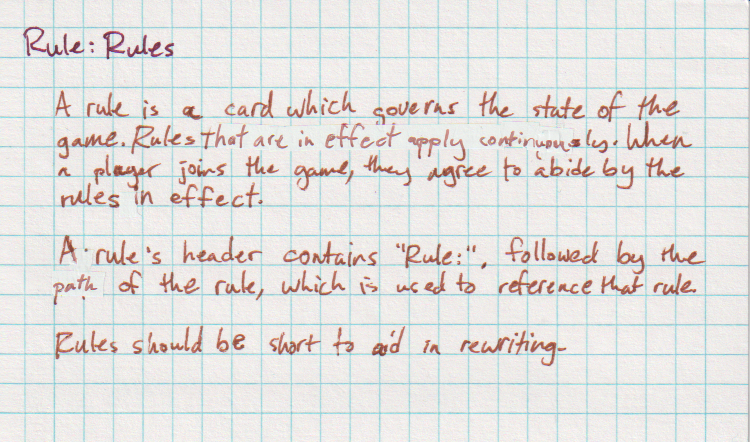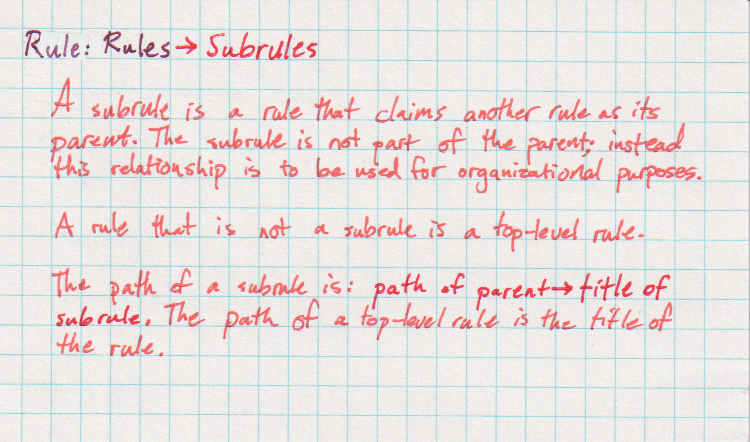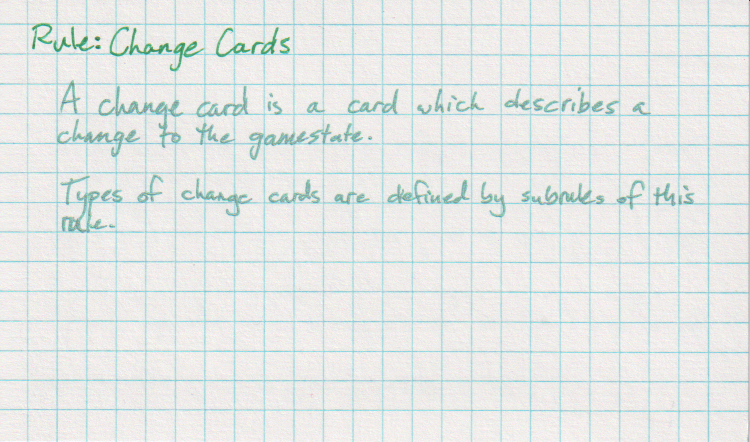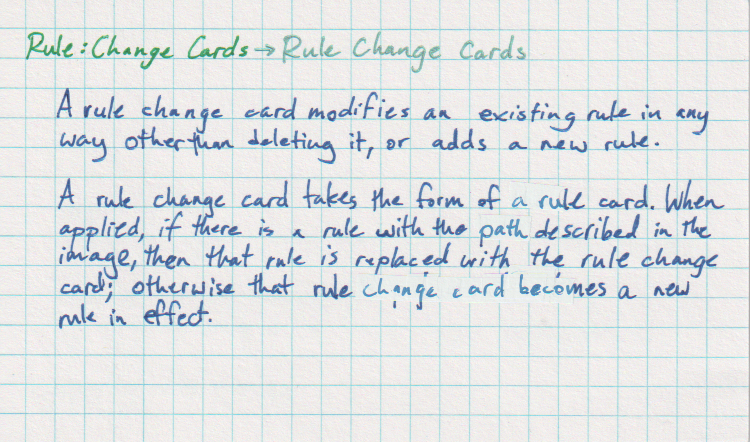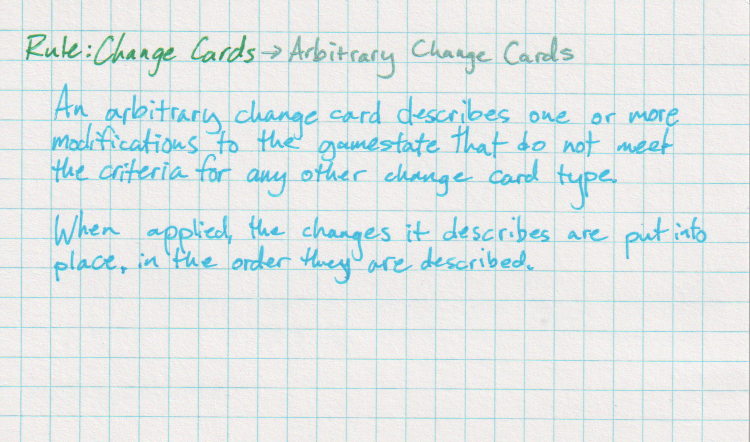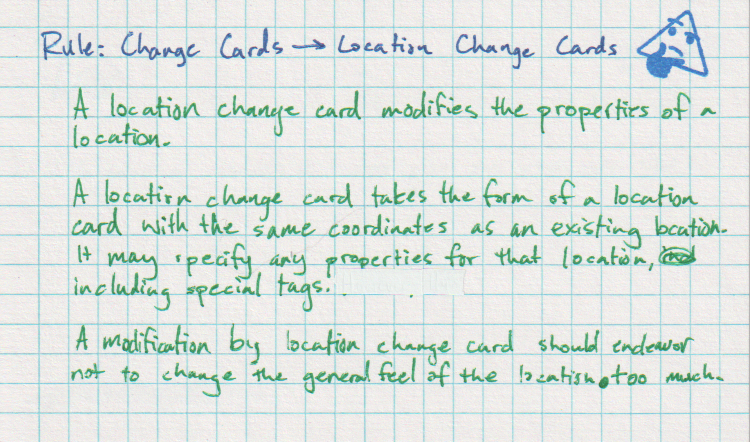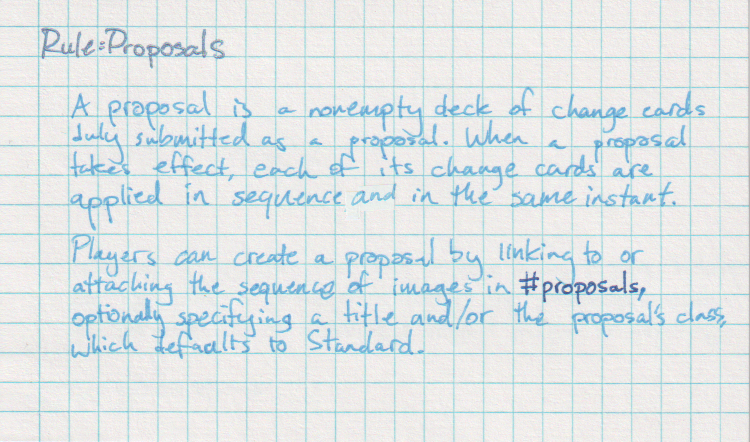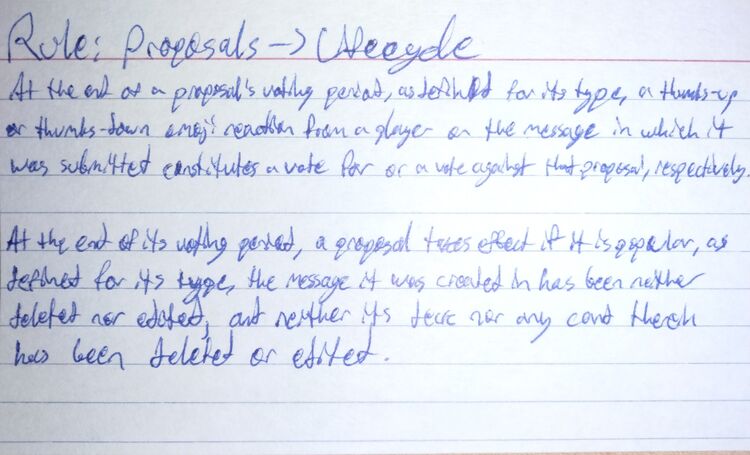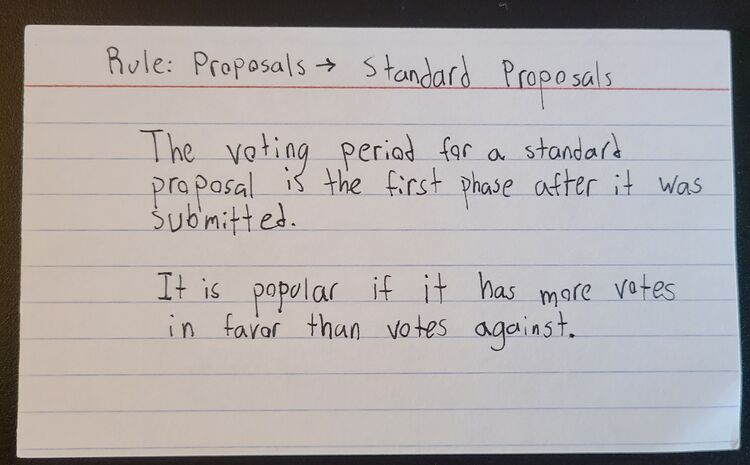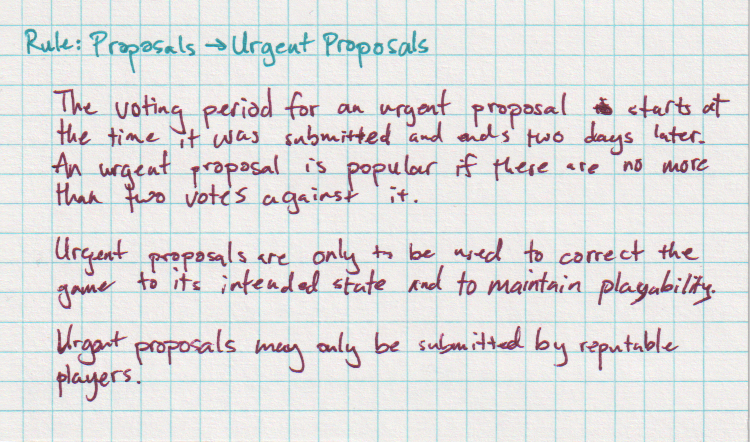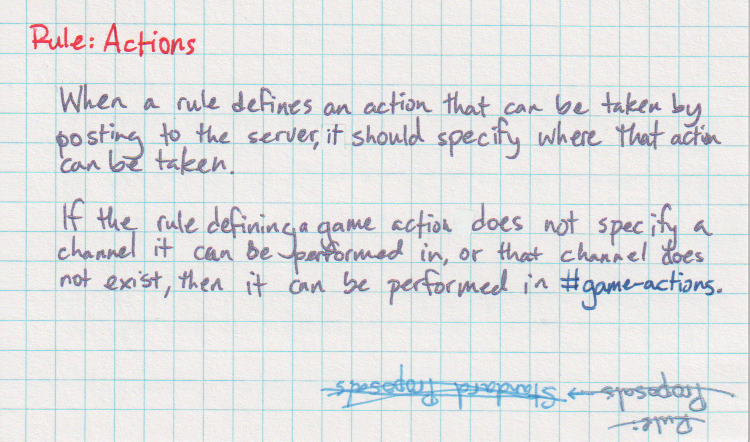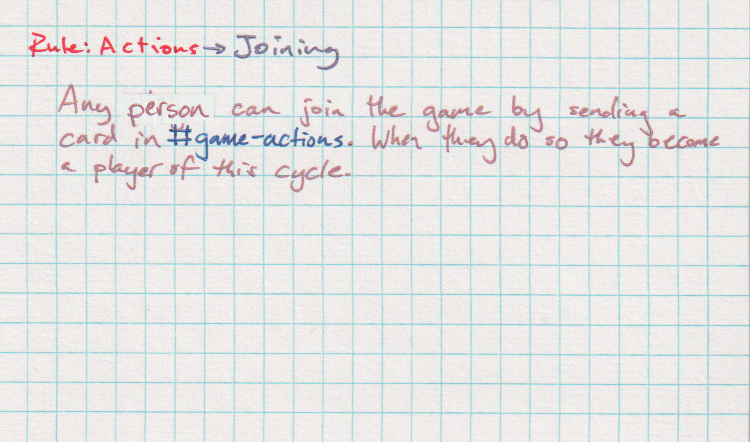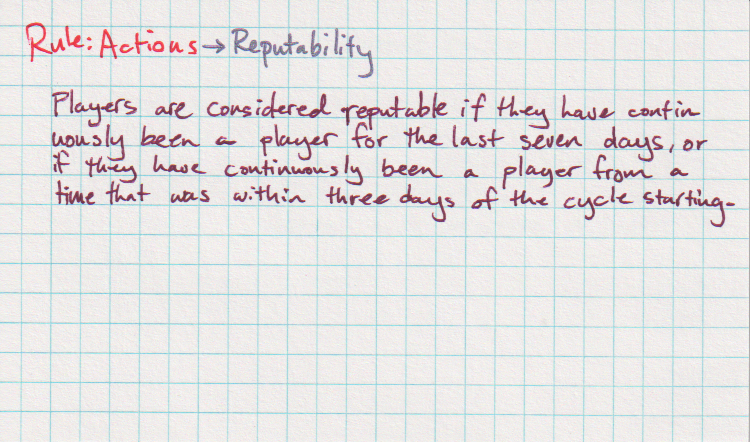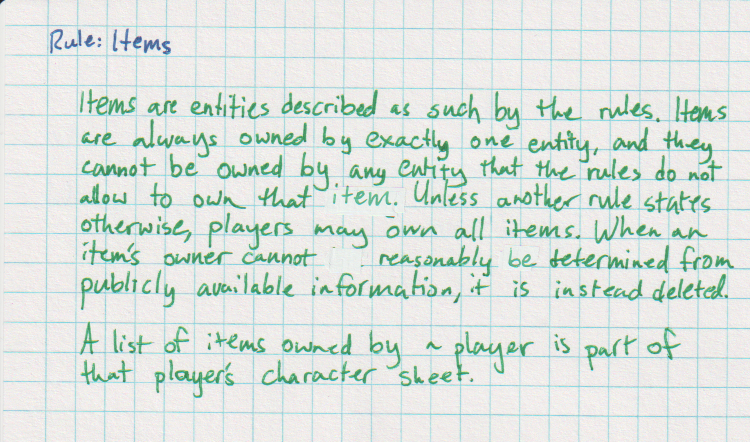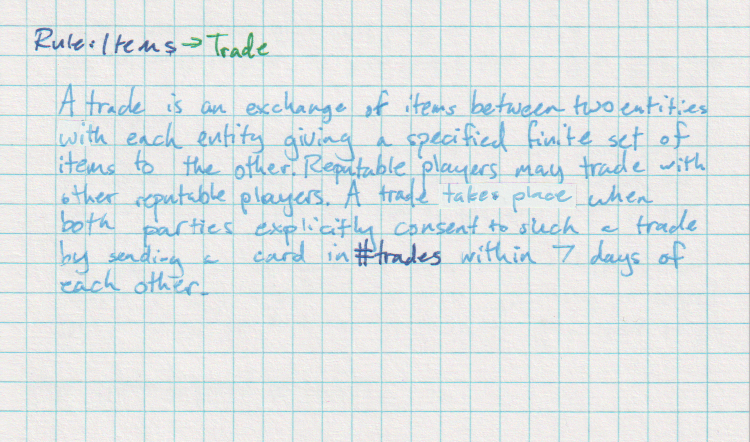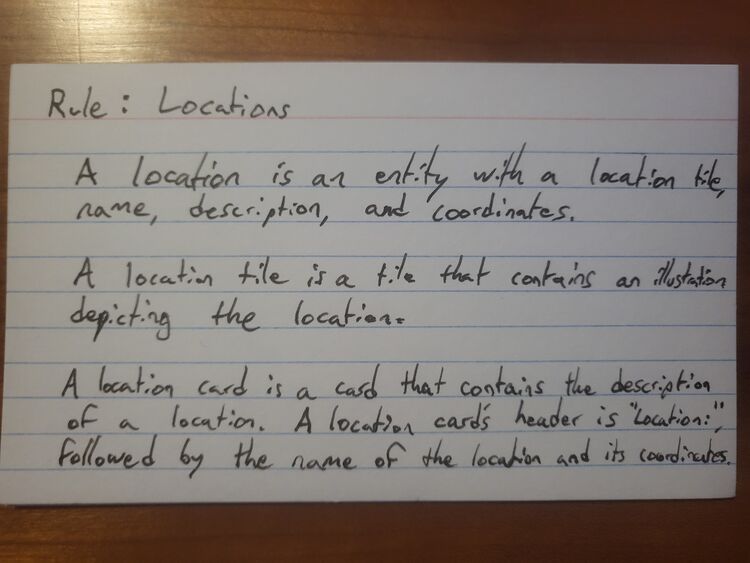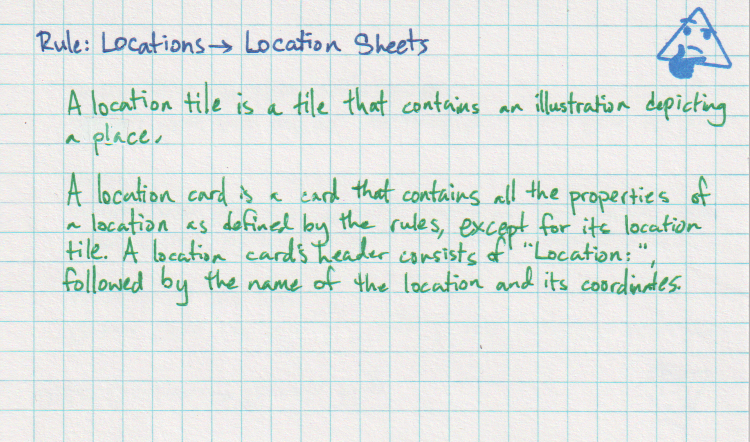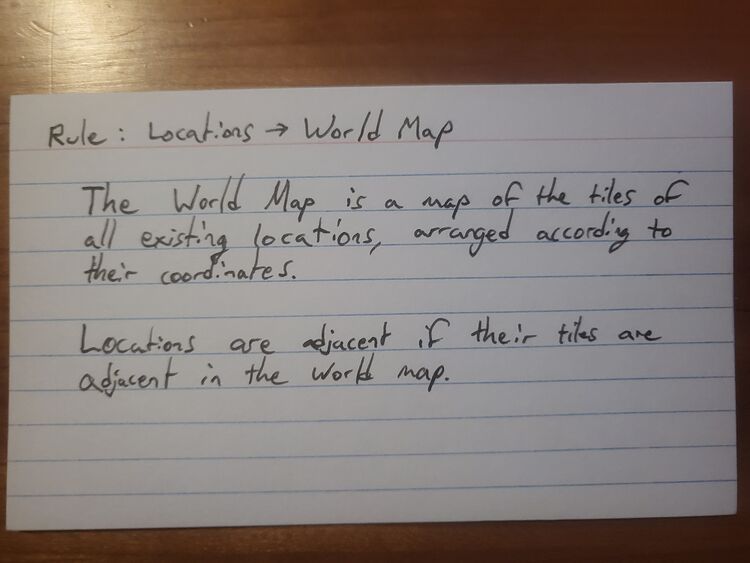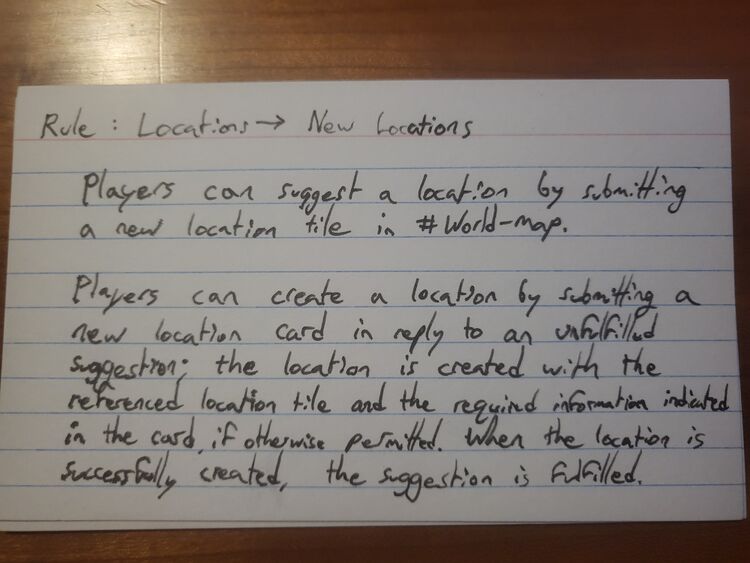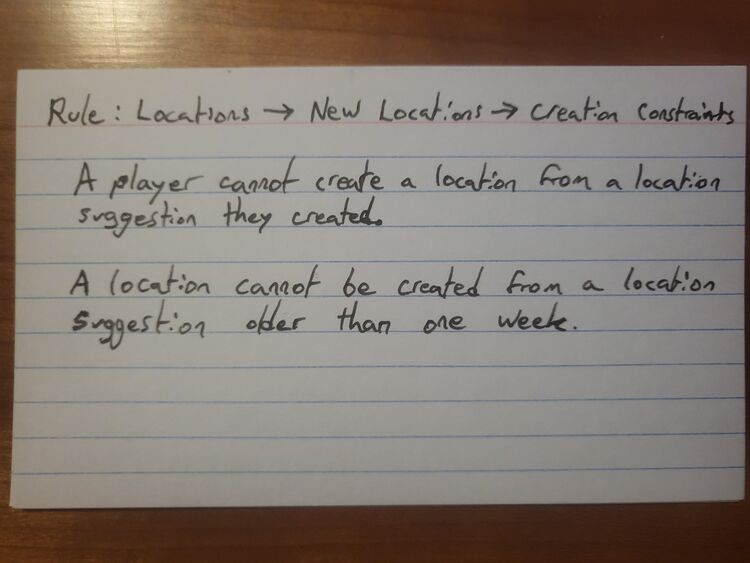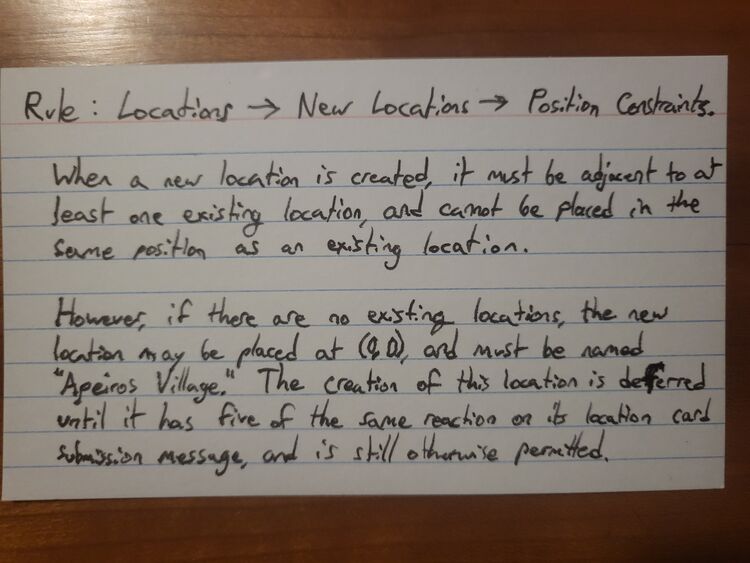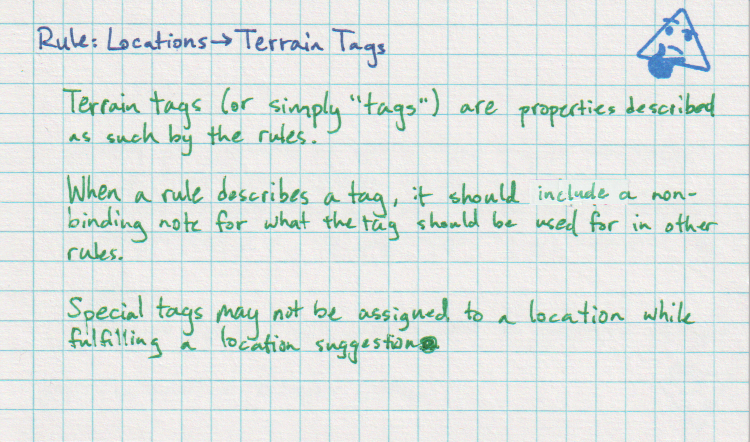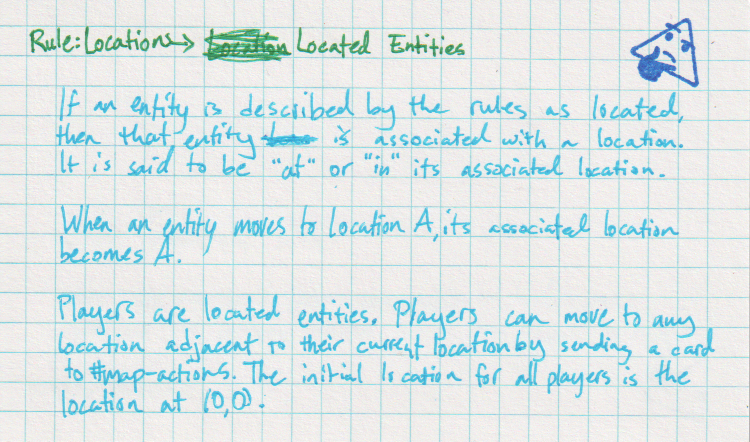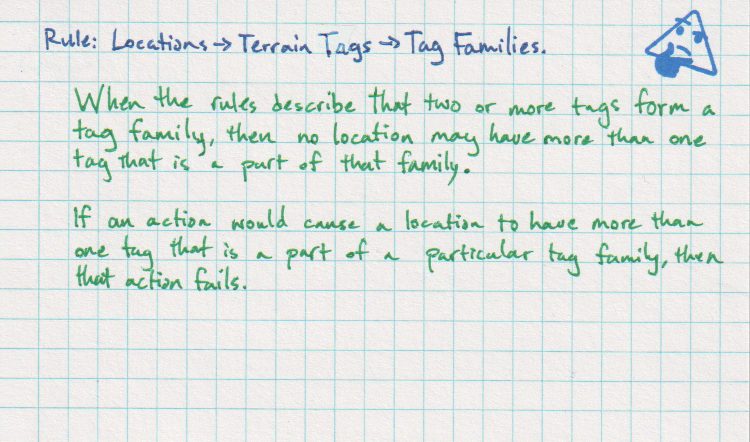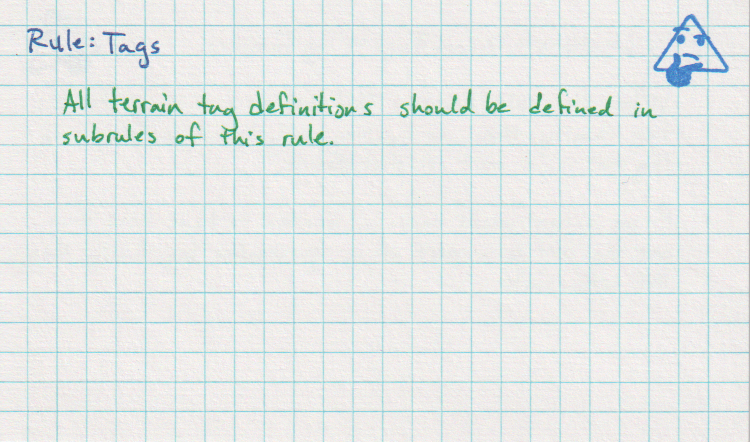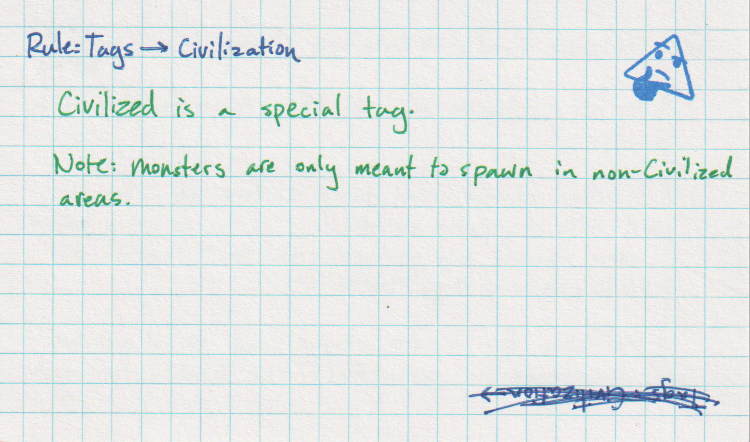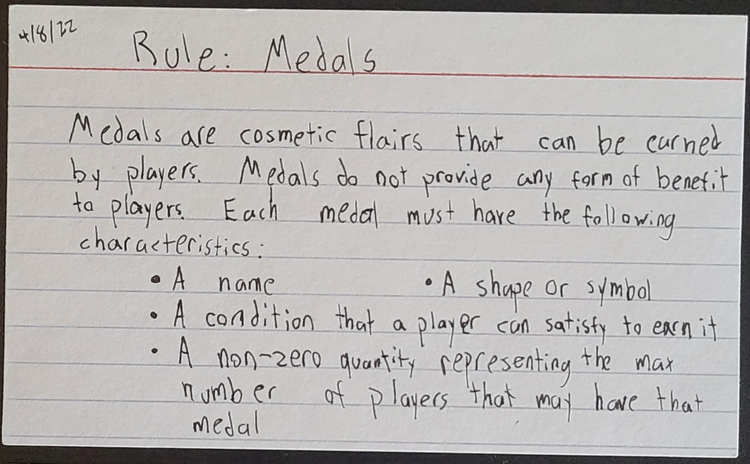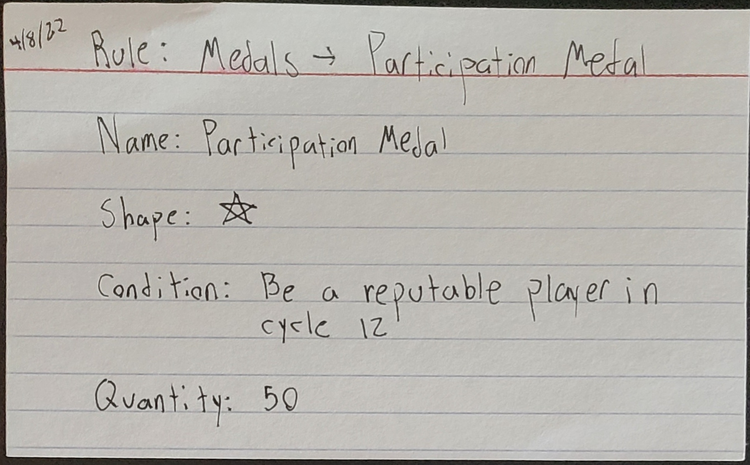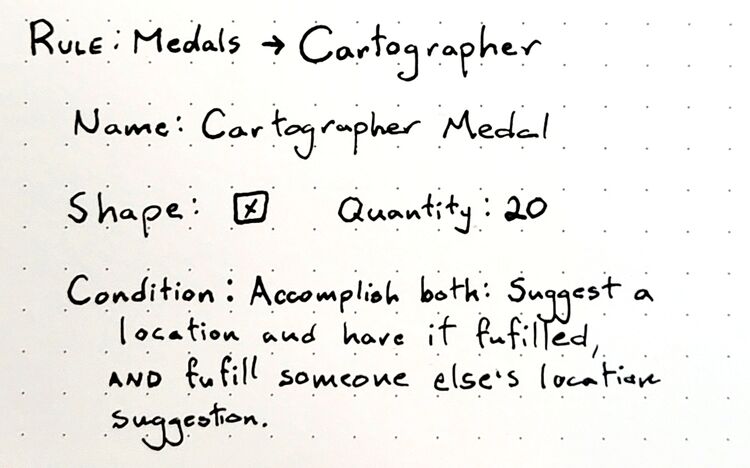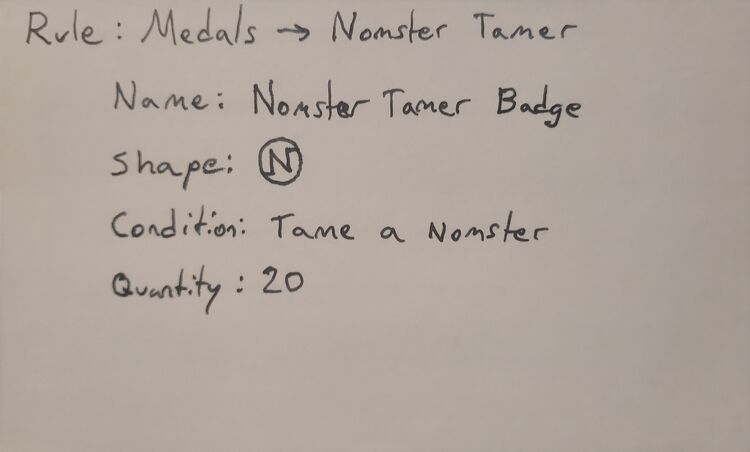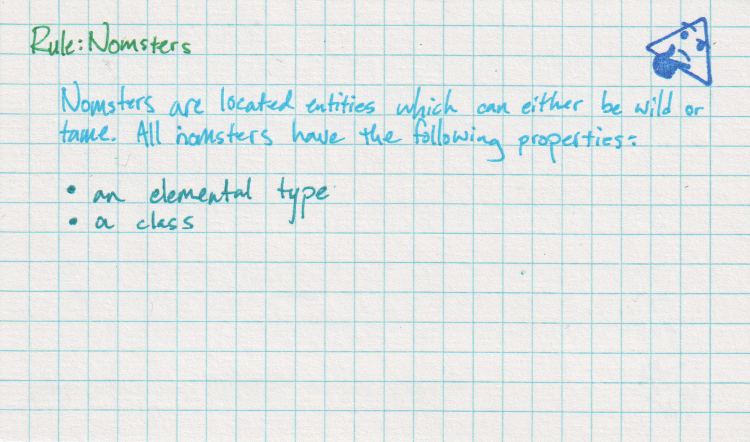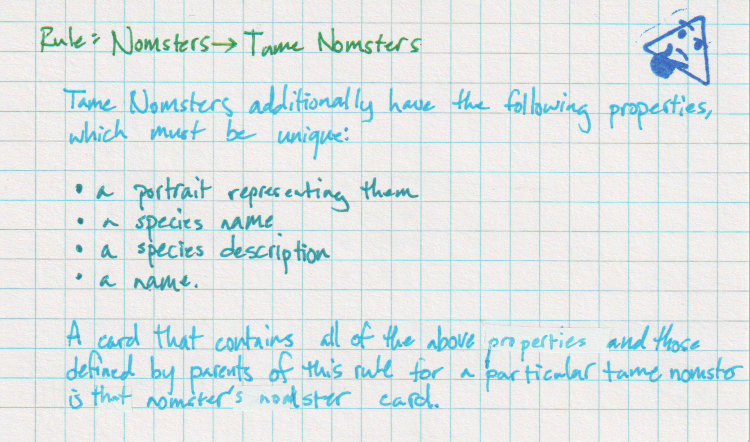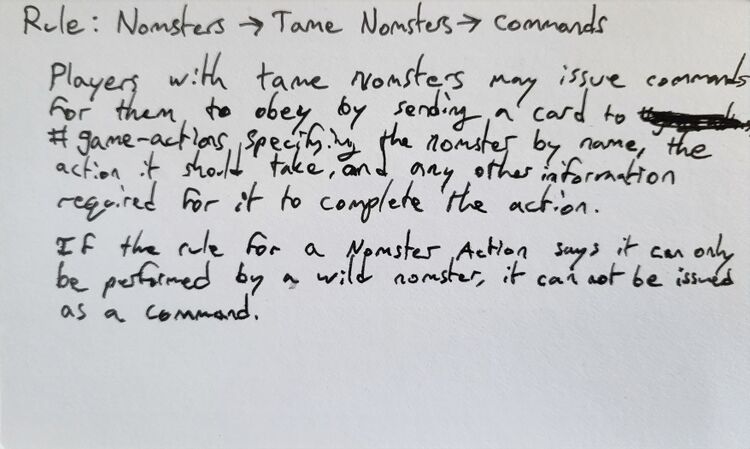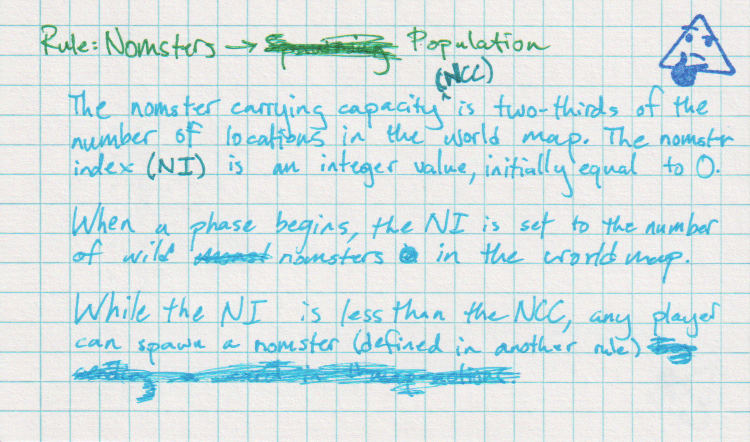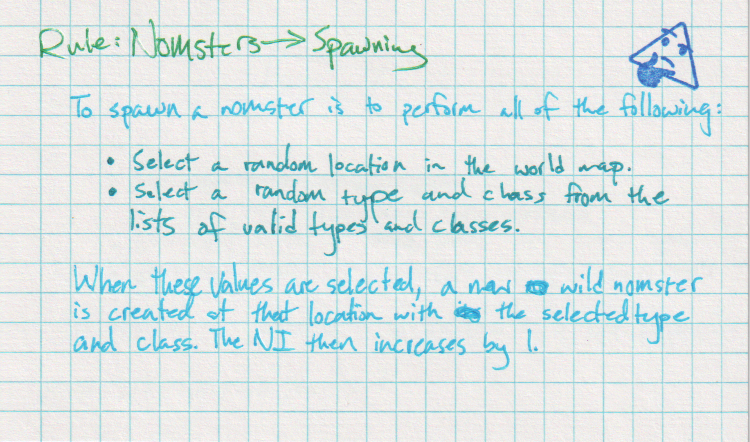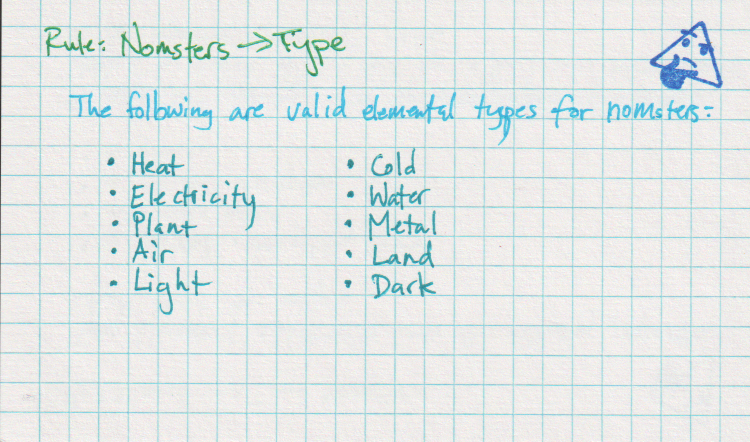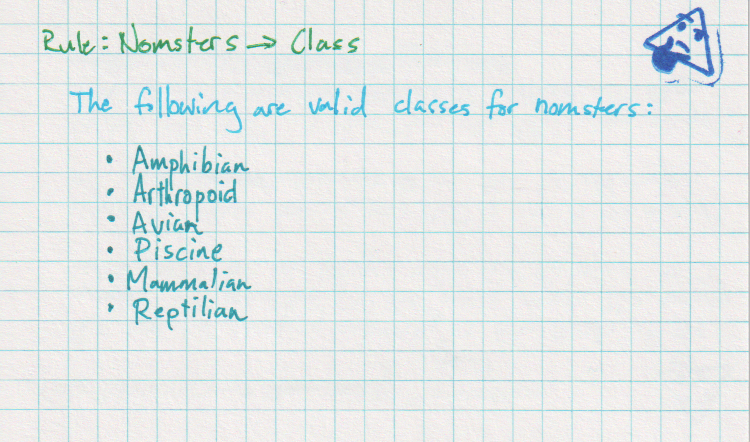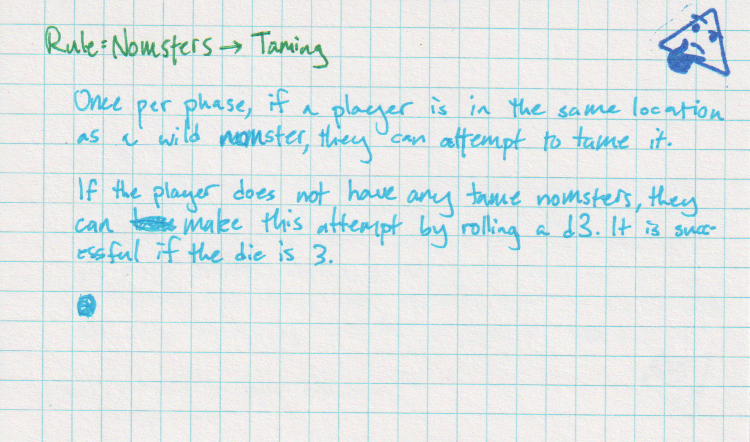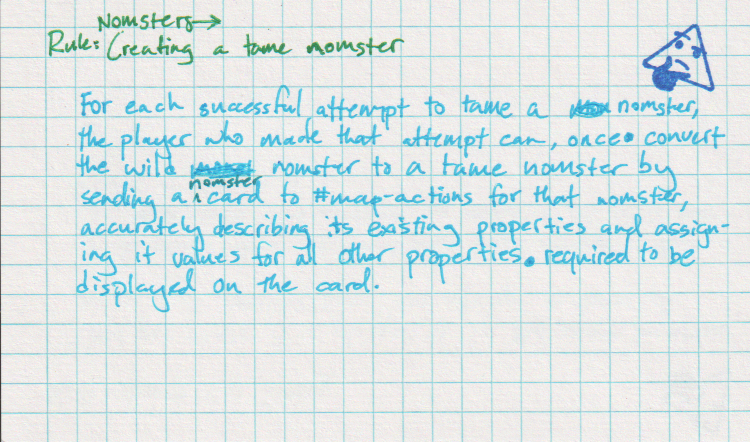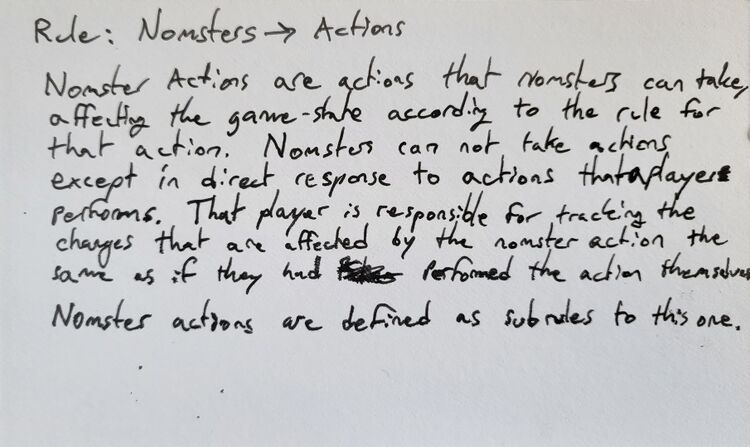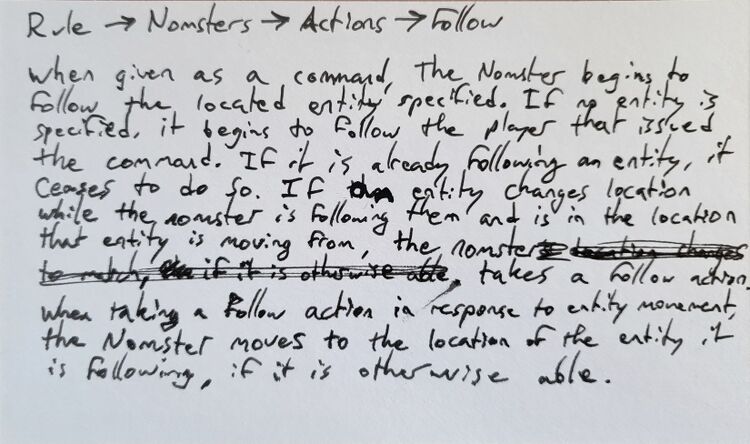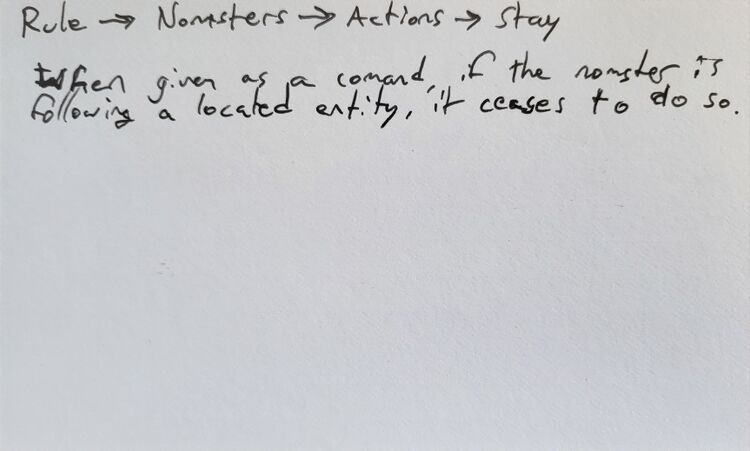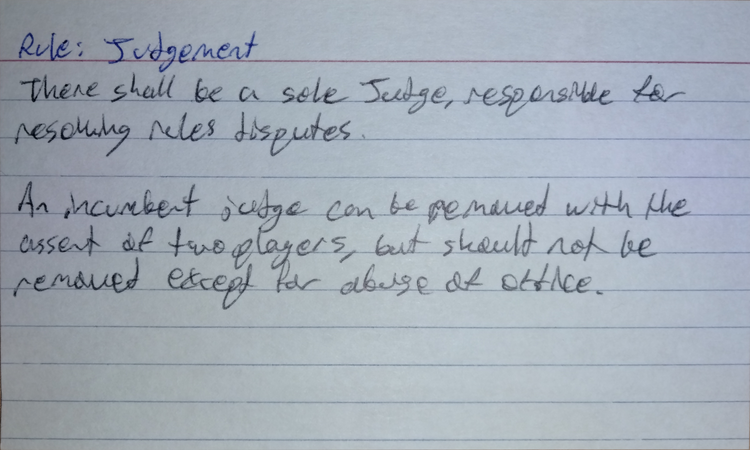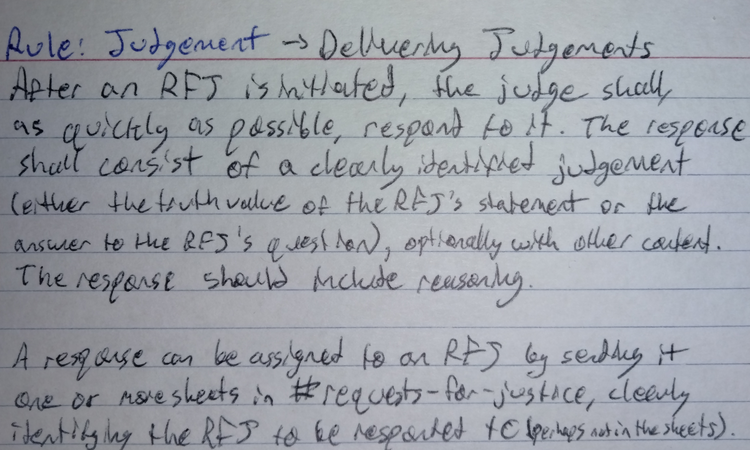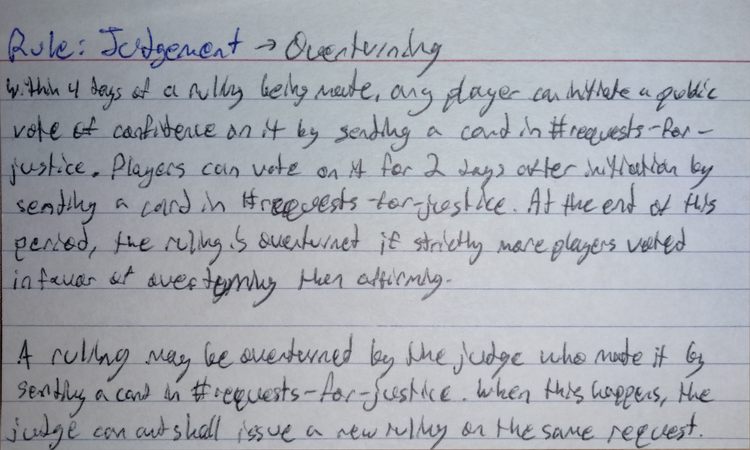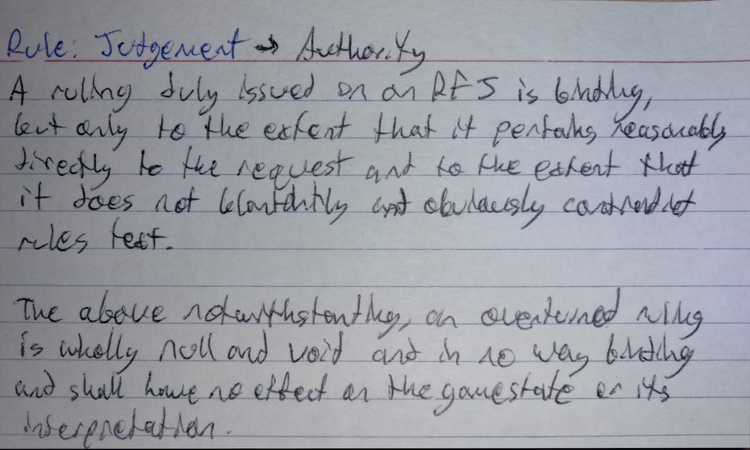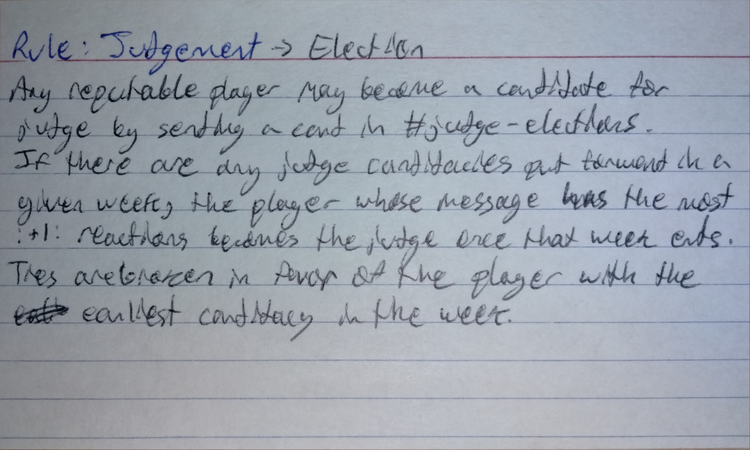Cycle 12/Ruleset
Time
Rule: Time
All times mentioned in the rules are in UTC. Days begin at 00:00 UTC. Weeks begin on Monday.
Each week is divided into two phases, containing the following days:
- • Monday, Tuesday, and Wednesday
- • Thursday, Friday, Saturday, and Sunday.
Phases are identified by successive Roman numerals; the First phase of the cycle is Phase I.
Sheets
Rule: Sheets
A sheet is an image of a writing surface, or portion thereof, which may have inscriptions. Everything on the surface must be hand-drawn or handwritten (perhaps with technological assistance) except for reasonable additions that do not reduce the handmade character. Players should ensure that they are capable of creating and uploading all types of sheets.
The header of a sheet (if any) is a section of the text set apart from the main content. A stack is an ordered set of sheets.
Transcription
Cards
Rule: Sheets → Cards
A card is a type of sheet. Cards should have an aspect ratio approximately equal to 4:3 and should contain only enough detail that they can be reproduced relatively easily on an index card.
A deck is an ordered set of cards.
Submissions
Rule: Sheets → Submission
To submit a sheet is to attach or link to that sheet in a message.
A new sheet is a sheet that has never been submitted before.
Tiles
Rule: Sheets → Tiles
A tile is a type of sheet. Tiles have an aspect ratio of 1:1.
A map is a 2-dimensional grid of non-overlapping tiles, indexed by integer coordinates.
A tile in a map is adjacent to the tiles surrounding that tile orthogonally.
Rules
Rule: Rules
A rule is a card which governs the state of the game. Rules that are in effect apply continuously. When a player joins the game, they agree to abide by the rules in effect.
A rule's header contains "Rule:", followed by the path of the rule, which is used to reference that rule.
Rules should be short to aid in rewriting.
Subrules
Rule: Rules → Subrules
A subrule is a rule that claims another rule as its parent. The subrule is not part of the parent; instead this relationship is to be used for organizational purposes.
A rule that is not a subrule is a top-level rule.
The path of a subrule is: path of parent → title of subrule. The path of the top-level rule is the title of the rule.
Change Cards
Rule: Change Cards
A change card is a card which describes a change to the gamestate.
Types of change cards are defined by subrules of this rule.
Rule Change Cards
Rule: Change Cards → Rule Change Cards
A rule change card modifies an existing rule in any way other than deleting it, or adds a new rule.
A rule change card takes the form of a rule card. When applied, if there is a rule with the path described in the image, then that rule is replaced with the rule change card; otherwise that rule change card becomes a new rule in effect.
Arbitrary Change Cards
Rule: Change Cards → Arbitrary Change Cards
An arbitrary change card describes one or more modifications to the gamestate that don not meet the criteria for any other change card type.
When applied, the changes it describes are put into place, in the order they are described.
Location Change Cards
Proposals
Rule: Proposals
A proposal is a nonempty deck of change cards duly submitted as a proposal. When a proposal takes effect, each of its change cards are applied in a sequence and in the same instant.
Players can create a proposal by linking to or attaching the sequence of images in #proposals, optionally specifying a title and/or the proposal's class, which defaults to Standard.
Lifecycle
Rule: Proposals → Lifecycle
At the end of a proposal's voting period as defined for its type, a thumbs-up and thumbs-down emoji reaction on the message in which the proposal was created represent a vote for or a vote against that proposal, respectively.
At the end of its voting period, a proposal takes effect if it is popular as defined for its type, the message in which it was created has not been edited or deleted, and none of its cards have been edited or deleted.
Standard Proposals
Rule: Proposals → Standard Proposals
The voting period for a standard proposal is the first phase after it was submitted. It is popular if it has more votes in favor than votes against.
A player cannot create a standard proposal if they have already submitted two standard proposals this week.
Urgent Proposal
Rule: Proposals → Urgent Proposals
The voting period for an urgent proposal starts at the time it was submitted and ends two days later. An urgent proposal is popular if there are no more than two votes against it.
Urgent proposals are only to be used to correct the game to its intended state and to maintain playability.
Urgent proposals may only be submitted by reputable players.
Actions
Rule: Actions
When a rule defines an action that can be taken by posting to the server, it should specify where that action can be taken.
If the rule defining a game action does not specify a channel it can be performed in, or that channel does not exist, then it can be performed in #game-actions.
Card Sending
Rule: Actions → Card Sending
When a rule dictates that an action can be taken by sending a card, then that action can be performed by attaching or linking to a card (in the relevant channel) showing unambiguously that they intend to perform that action.
Joining
Rule: Actions → Joining
Any person can join the game by sending a card in #game-actions. When they do so they become a player of this cycle.
Reputability
Rule: Actions → Reputability
Players are considered reputable if they have continuously been a player for the last seven days, or if tey have continuously been a player from a time that was within three days of the cycle starting.
Tracking
Rule: Tracking
A character sheet for a player is a sheet which should act as the basic form of gamestate tracking. It must contain all the information required of it by the rules, otherwise it is not a character sheet. Its header shall contain the words "Character Sheet" and the player it was created for.
Self-Updating
Rule: Tracking → Self-Updating
When a player takes some actions that change one or more values required to be tracked on their character sheet, they must attach or link to a new character sheet that reflects the gamestate as it would be if those actions were to succeed. This is called "Self-Updating".
Update Notifications
Rule: Tracking → Update Notifications
When a player takes some actions that would modify one or more values required to be tracked on another player's Character Sheet, they shall notify that person through Discord ping so that they may include those changes in their character sheet.
Medal Box
Rule: Tracking → Medal Box
A player's medals are tracked on their character sheet in a special portion labeled "Medal Box". Nothing may be inside this portion of the sheet except for icons representing medals that player has earned.
Items
Rule: Items
Items are entities described as such by the rules. Items are always owned by exactly one entity, and they cannot be owned by any entity that the rules do not allow to own that item. Unless another rule states otherwise, players may own all items. When an item's owner cannot reasonably be determined from publicly available information, it is instead deleted.
A list of items owned by a player is part of that player's character sheet.
Actions
Rule: Items → Item Actions
For an entity to gain an item is for that item to be created in that entity's possession.
For an entity to lose an item is for that item to be destroyed from that entity's possession. To revoke an item from an entity is to destroy it from that entity's possession.
For entity A to take an item from entity B is for that item to be transferred from entity B to entity A.
Trade
Rule: Items → Trade
A trade is an exchange of items between two entities with each entity giving a specified finite set of items to the other. Reputable players may trade with other reputable players. A trade takes place when both parties explicitly consent to such a trade by sending a card in #trades within 7 days of each other.
Locations
Rule: Locations
A location is an entity with a location tile, name, description, and coordinates.
A location tile is a tile that contains an illustration depicting the location.
A location card is a card that contains the description of a location. A location card's header is "Location: ", followed by the name of the location and its coordinates.
Location Sheets
World Map
Rule: Locations → World Map
The World map is a map of the tiles of all existing locations, arranged according to their coordinates.
Locations are adjacent if their tiles are adjacent in the World Map.
New Locations
Rule: Locations → New Locations
Players can suggest a location by submitting a new location tile in #world-map.
Players can create a location by submitting a new location card in reply to an unfulfilled suggestion; the location is created with the referenced location tile and the required information indicated in the card, if otherwise permitted. When the location is successfully created, the suggestion is fulfilled.
Creation Constraints
Rule: Locations → New Locations → Creation Constraints
A player cannot create a location from a location suggestion they created.
A location cannot be created from a location suggestion older than one week.
Position Constraints
Rule: Locations → New Locations → Position Constraints
When a new location is created, it must be adjacent to at least one existing location, and cannot be placed in the same position as an existing location.
However, if there are no existing locations, the new location may be placed at (0, 0), and must be named "Apeiros Village." The creation of this location is deferred until it has five of the same reaction on its location card submission message, and is still otherwise permitted.
Terrain Tags
Located Entities
Tag Families
Tags
Civilization
Medals
Rule: Medals
Medals are cosmetic flairs that can be earned by players. Medals do not provide any form of benefit to players. Each medal must have the following characteristics:
- • A name
- • A shaper or symbol
- • A condition that a player can satisfy to earn it
- • A non-zero quantity representing the max number of players that may have that medal.
Participation
Rule: Medals → Participation Medal
Name: Participation Medal
Shape: ⚝
Condition: Be a reputable player in cycle 12
Quantity: 50
Cartographer
Rule: Medals → Cartographer
Name: Cartographer Medal
Shape: A square with an X in the middle.
Quantity: 20
Condition: Accomplish both: Suggest a location and have it fufilled, AND fufill someone else's location suggestion.
Nomster Tamer
Rule: Medals → Nomster Tamer
Name: Nomster Tamer Badge
Shape: A circle with an N in the middle.
Condition: Tame a Nomster.
Quantity: 20
Nomsters
Tame Nomsters
Commands
Rule: Nomsters → Tame Nomsters → Commands
Players with tame Nomsters may issue commands for them to obey by sending a card to #game-actions specifying the nomster by name, the action it should take, and any other information required for it to complete the action.
If the rule for a Nomster Action says it can only be performed by a wild nomster, it can not be issued as a command.
Population
Spawning
Type
Class
Taming
Creating a Tame Nomster
Actions
Nomster Actions are actions that Nomsters can take, affecting the game-state according to the rule for that action. Nomsters can not take actions except in direct response to actions that a player performs. That player is responsible for tracking the changes that are affected by the nomster action the same as if they had performed the action themselves.
Nomster actions are defined as subrules to this one.
Follow
Rule: Nomsters → Actions → Follow
When given as a command, the Nomster begins to follow the located entity specified. If no entity is specified, it begins to follow the player that issued the command. If it is already following an entity, it ceases to do so. If an entity changes location while the nomster is following them and is in the location that entity is moving from, the nomster takes a follow action.
When taking a follow action in response to entity movement, the Nomster moves to the location of the entity it is following, if it is otherwise able.
Stay
Rule: Nomsters → Actions → Stay
When given as a comand, if the nomster is following a located entity, it ceases to do so.
Judgement
Rule: Judgement
There shall be a sole Judge, responsible for resolving rules disputes.
An incumbent judge can be removed with the assent of two players, but should not be removed except for abuse of office.
Requests for Judgement
Rule: Judgement → Requests for Justice
Any person can initiate a Request for Justice (RFJ) by sending one or more sheets in #requests-for-justice. The sheets must clearly identify a single statement to be judged and may contain other content.
An RFJ can be initiated on a question instead of a statement, but this is discouraged.
Delivery
Rule: Judgement → Delivery Judgements
After an RFJ is initiated, the judge shall, as quickly as possible, respond to it. The response shall consist of a clearly identified judgement (either the truth value of the RFJ's statement or the answer to the RFJ's question), optionally with other content. The response should include reasoning.
A response can be assigned to an RFJ by sending it one or more sheets in #requests-for-justice, clearly identifying the RFJ to be responded to (perhaps not in the sheets).
Overturning
Rule: Judgement → Overturning
Within 4 days of a ruling being made, any player can initiate a public vote of confidence on it by sending a card in #requests-for-justice. Players can vote on it for 2 days after initiation by sending a card in #requests-for-justice. At the end of this period, the ruling is overturned if strictly more players voted in favor of overturning than affirming.
A ruling may be overturned by the judge who made it by sending a card in #requests-for-justice. When this happens, the judge can and shall issue a new ruling on the same request.
Authority
Rule: Judgement → Authority
A ruling duly issued on an RFJ is binding, but only to the extent that is pertains reasonably directly to the request and to the extent that it does not blatantly and obviously contradict rules text.
The above notwithstanding, an overturned ruling is wholly null and void and in no way binding and shall have no effect on the gamestate or its interpretation.
Election
Rule: Judgement → Election
Any reputable player may become a candidate for judge by sending a card in #judge-elections. If there are any judge candidates put forward in a given week, the player whose message has the most :+1: reactions becomes the judge once that week ends. Ties are broken in favor of the player with the easiest candidacy in the week.
